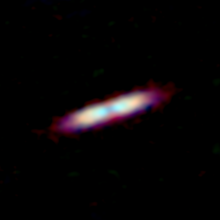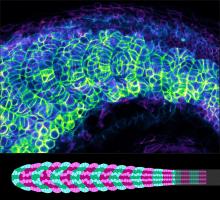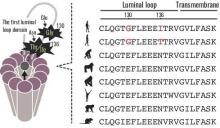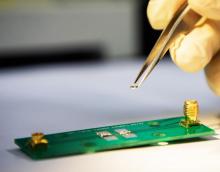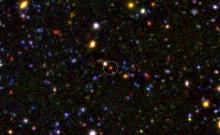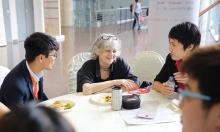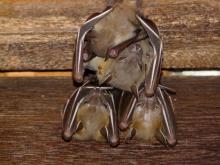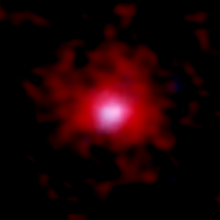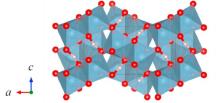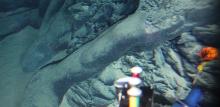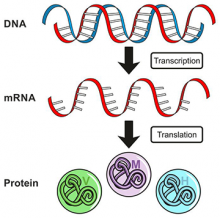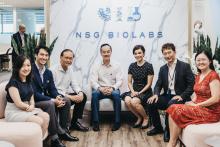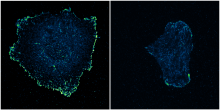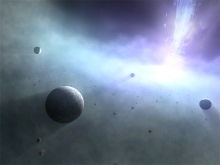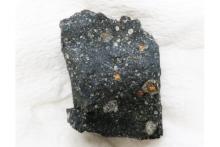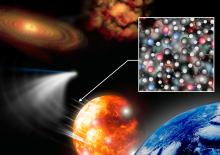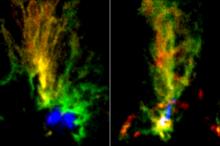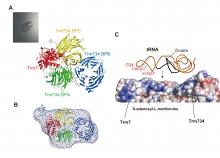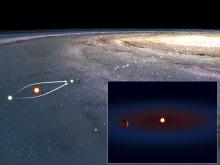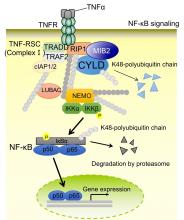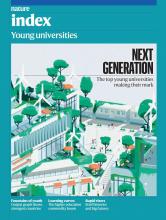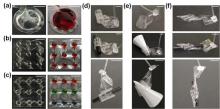Science
News
23 Dec 2019
NUS researchers found that chevron patterns in fish swimming muscles require physical forces to correctly develop, not only from genetic instruction or biochemical pathways.
23 Dec 2019
Researchers revealed the evolutionary changes in neurotransmitter uptake of VMAT1 by reconstructing ancestral VMAT1 proteins.
20 Dec 2019
Four top research academics from The Chinese University of Hong Kong (CUHK) were presented with prestigious awards from the Croucher Foundation. Professor Jianfang Wang, Professor, Department of Physics received the Croucher Senior Research Fellowship 2020. Two scholars from the Department of Medicine and Therapeutics of the Faculty of Medicine, Professor Ronald Ching Wan Ma, Professor and Head of the Division of Endocrinology and Diabetes, and Professor Siew Chien Ng, Professor, Division of Gastroenterology and Hepatology and Associate Director of the Centre for Gut Microbiota Research were awarded the Croucher Senior Medical Research Fellowships 2020. Professor Renjie Zhou, Assistant Professor, Department of Biomedical Engineering was awarded the Croucher Innovation Award 2019.
20 Dec 2019
Nine professors of The Chinese University of Hong Kong (CUHK) have earned the honour of being named in the list of “Highly Cited Researchers 2019” as among the world’s top researchers who have demonstrated significant and broad influence reflected in their publication of multiple papers, highly cited by fellow academics.
20 Dec 2019
Research groups led by Professor Swee Kuan Goh, Associate Professor and Professor Sen Yang, Assistant Professor, both from the Department of Physics at The Chinese University of Hong Kong (CUHK) have joined forces in developing and applying colour centres in nano-diamonds as a tool for studying the characteristics of quantum materials under extreme conditions.
19 Dec 2019
A distant galaxy more massive than our Milky Way has revealed that the 'cores' of massive galaxies in the Universe had formed already 1.5 billion years after the Big Bang.
17 Dec 2019
The Global Young Scientists Summit 2020 in Singapore gathers new and returning eminent scientists and talented young researchers worldwide to convene in Singapore, to spark new ideas and innovations.
17 Dec 2019
A team of researchers from the National University of Singapore has found that the effective population size and genetic diversity of Singapore’s Cynopterus brachyotis, believed to remain widely unaffected by urbanisation, has shrunk significantly over the last 90 years – revealing that the current biodiversity crisis may be much broader than widely assumed, affecting even species thought to be common and tolerant of fragmentation and habitat loss.
16 Dec 2019
Researchers have discovered gigantic clouds of gaseous carbon more than a radius of 30,000 light-years around young galaxies using ALMA.
10 Dec 2019
A new hydrous phase, ε-AlOOH, was observed to be stable at pressures above ~200 GPa. The stability of ε-AlOOH at extremely high pressures may affect the modelling results of the internal structure and deep water circulation of some extra-solar planets, such as terrestrial super-Earths, because the hydroxide may store water in these regions.
09 Dec 2019
A chemical cage suppresses the activity of a biological clock regulator in the dark and releases it with light, showing potential for future treatments of circadian-clock-related diseases.
06 Dec 2019
Scientists in Korea find a protein that mediates the interaction between the cellular systems involved in rapid responses against foreign genes in plants
04 Dec 2019
Researchers from Tohoku University have discovered a new petit-spot volcano at the oldest section of the Pacific Plate. The research team, led by Associate Professor Naoto Hirano of the Center for Northeast Asian Studies, published their discovery in the in the journal Deep-Sea Research Part I.
28 Nov 2019
Despite great investments, an effective drug-based treatment for Alzheimer’s disease, the most common form of dementia among the elderly, remains elusive. Scientists led by Duke-NUS Medical School, in collaboration with Monash University, have published an online atlas of gene expressions at single-cell level in Alzheimer’s disease brains, aiming to boost to efforts to identify gene targets for drug development.
27 Nov 2019
Singapore’s first and largest co-working laboratory and office space is fully equipped and designed to help biotech start-ups commercialise breakthrough innovations
26 Nov 2019
Researchers from the Mechanobiology Institute at the National University of Singapore have shown that cells can attach to the fibrous protein meshwork that surrounds them only if the fibres are spaced close enough. The team’s findings can explain the abnormal motility patterns displayed by cancer cells.
25 Nov 2019
Theoreticians in two different fields defied the common knowledge that planets orbit stars like the Sun. They proposed the possibility of thousands of planets around a supermassive black hole.
22 Nov 2019
A new study has discovered meteorites containing RNA sugar, ribose, and other bio-important sugars; the first direct evidence of bio-essential sugars' delivery from space to the Earth.
19 Nov 2019
Using the Cooled Mid-Infrared Camera and Spectrometer on the Subaru Telescope, astronomers have detected an unidentified infrared emission band from comet 21P/Giacobini-Zinner in addition to the thermal emissions from silicate and carbon grains.
14 Nov 2019
Two peacock-shaped gaseous clouds were revealed in the Large Magellanic Cloud by observations with Atacama Large Millimeter/submillimeter Array.
14 Nov 2019
Foremost society of kidney specialists highlights Singapore-led global study to better understand diabetes complications and reduce their prevalence.
06 Nov 2019
Groups in Ehime University, Japan and the High Energy Accelerator Research Organization (KEK), Japan have solved the crystal structure of the eukaryotic Trm7-TRm734 complex, which methylates the ribose at the first position of anticodon in tRNA. They have clarified the tRNA recognition mechanism of this complex and the functions of its subunits based on the crystal structure. This study was published in Nucleic Acids Research on October 5, 2019.
01 Nov 2019
Researchers using telescopes around the world confirmed and characterized an exoplanet orbiting a nearby star through gravitational microlensing.
01 Nov 2019
Antibodies against viruses from the same family as Ebola and Marburg have been detected in fruit bats and the human community hunting them, indicating cross-species virus transmission has occurred in the past, warns a global team of infectious disease scientists.
29 Oct 2019
A team of researchers at Ehime University revealed that E3 ubiquitin ligase MIB2 enhances inflammation by degrading the deubiquitinating enzyme CYLD. This finding was published on September 20 in The Journal of Biological Chemistry.
25 Oct 2019
New Nature Index rankings of universities aged 50 and under reveal that institutes in Asian countries are performing particularly well in terms of output of high-quality research
23 Oct 2019
Two new Pd-based initiating systems for C1 polymerization of diazoacetates were reported: Pd(nq)2/borate (nq = naphthoquinone, borate = NaBPh4) and [Pd(cod)(Cl-nq)Cl/borate] [cod = 1,5-cyclooctadiene, Cl-nq = 2,3-dichloro-1,4-naphthoquinone]. The former exhibited high activity, affording poly(alkoxycarbonylmethylene)s with high molecular weights in high yields. The latter was effective for controlling the stereostructure of the resulting polymers.
21 Oct 2019
DGIST Professor Sohee Kim’s Team developed a technology to produce 3D soft and flexible devices by blowing balloons made of polymeric thin films. Can be made in various 3D shapes... Expected to have diverse medical and biomedical applications.
18 Oct 2019
Nitrogen-embedded polycyclic compounds with strong antiaromaticity and stability were synthesized and isolated for the first time using pyrrole as a key unit. An expedited approach toward stable antiaromatic polycyclic compounds enables not only the revealing of its fundamental properties, but also its application to organic electronic materials.
Giants in history
Chinese biochemist Chi Che Wang (1894 - 1979), one of the first Chinese women to study abroad, advanced to prominent research positions at American institutions including the University of Chicago and the Northwestern University Medical School.
Ruby Sakae Hirose (1904 – 1960) was a Japanese-American scientist whose research contributed significantly to our understanding of blood clotting, allergies and cancer.
Chinese electron microscopy specialist Li Fanghua (6 January 1932 – 24 January 2020) facilitated the high-resolution imaging of crystal structures by eliminating interference.
Sálim Moizuddin Abdul Ali (12 November 1896 – 20 June 1987), commonly referred to as the Birdman of India, was the first person to conduct systematic surveys of birds from across India.
Haisako Koyama (1916 – 1997) was a Japanese solar observer whose dedication to recording sunspots – cooler parts of the sun’s surface that appear dark – produced a sunspot record of historic importance.
Michiaki Takahashi (17 February 1928 – 16 December 2013) was a Japanese virologist who developed the first chickenpox vaccine.
Toshiko Yuasa (11 December 1909 – 1 February 1980) was the first Japanese female physicist whose research on radioactivity shed light on beta decay – the process in which an atom emits a beta particle (electron) and turns into a different element.
Angelita Castro Kelly (1942-2015) was the first female Mission Operations Manager (MOM) of NASA. She spearheaded and supervised the Earth Observing System missions during its developmental stage.
Malaysia’s first astrophysicist, Mazlan binti Othman (born 11 December 1951) was instrumental in launching the country’s first microsatellite, and in sending Malaysia’s first astronaut, Sheikh Muszaphar Shukor, into space.
Known as Mr. Natural Rubber, chemist and researcher B. C. Shekhar (17 November 1929 – 6 September 2006) introduced a number of technical innovations that helped put Malaysia’s natural rubber industry on the world map.
Shinichiro Tomonaga (31 March 1906 – 8 July 1979), together with Richard Feynman and Julian Schwinger, was awarded the Nobel Prize in Physics in 1965, for their contributions to advance the field of quantum electrodynamics. Tomonaga was also a strong proponent of peace, who actively campaigned against the proliferation of nuclear weapons and promoted the peaceful use of nuclear energy.
South Korean theoretical physicist Daniel Chonghan Hong (3 March 1956 – 6 July 2002) achieved fame in the public sphere through his research into the physics of popcorn.
Japanese chemist Kenichi Fukui (4 October 1918 – 9 January 1998) was the first Asian scientist to be awarded the Nobel Prize in Chemistry. Together with Roald Hoffman, he received this honour in 1981 for his independent research into the mechanisms of chemical reactions.
Chinese palaeontologist, archaeologist and anthropologist Pei Wenzhong (January 19, 1904 – September 18, 1982) is regarded as a founder of Chinese anthropology.
Physicist Narinder Singh Kapany (31 October 1926 – 4 December 2020) pioneered the use of optical fibres to transmit images, and founded several optical technology companies. Born in Punjab, India, he worked at a local optical instruments factory before moving to London for PhD studies at Imperial College. There, he devised a flexible fibrescope to convey images along bundles of glass fibres.
Japanese physicist Ukichiro Nakaya (1900-1962) made the world’s first artificial snowflakes. He started his research on snow crystals in the early 1930s at Hokkaido University, where there is an unlimited supply of natural snow in winter. By taking over 3,000 photographs, he established a classification of natural snow crystals and described their relationship with weather conditions.
The field of solid-state ionics originated in Europe, but Takehiko Takahashi of Nagoya University in Japan was the first to coin the term ‘solid ionics’ in 1967. ‘Solid-state ionics’ first appeared in 1971 in another of his papers, and was likely a play on ‘solid-state electronics’, another rapidly growing field at the time.
Charles Kuen Kao (Nov. 4, 1933 to Sept. 23, 2018) was an engineer who is regarded as the father of fibre optics. His work in the 1960s on long distance signal transmission using very pure glass fibres revolutionized telecommunications, enabling innovations such as the Internet.
Chika Kuroda (24 March 1884 – 8 November 1968) was a Japanese chemist whose research focussed on the structures of natural pigments.
Motoo Kimura (13 November 1924 – 13 November 1994) was a Japanese theoretical population geneticist who is best remembered for developing the neutral theory of molecular evolution.
Meghnad Saha (6 October 1893 – 16 February 1956) was an Indian astrophysicist best known for formulating the Saha ionization equation which describes the chemical and physical properties of stars.
Sir Jagadish Chandra Bose (30 November 1858 – 23 November 1937) was a scientist and inventor who contributed to a wide range of scientific fields such as physics, botany and biology.
Osamu Shimomura (27 August 1928 – 19 October 2018) was a Japanese organic chemist and marine biologist who dedicated his career to understanding how organisms emitted light.
Subrahmanyan Chandrasekhar (19 October 1910 – 21 August 1995) was an Indian astrophysicist who studied the structure and evolution of stars.
Joo-myung Seok (November 13, 1908 – October 6, 1950) was a Korean butterfly entomologist who made important contributions to the taxonomy of the native butterfly species in Korea.
Mathematician Maryam Mirzakhani (12 May 1977 – 14 July 2017) was the first and only woman and Iranian to date to win the Fields Medal in 2014 for her work on curved surfaces.
Sir Chandrasekhara Venkata Raman (7 November 1888 – 21 November 1970) was an Indian physicist who performed ground-breaking research in the field of light-scattering.
Mohammad Abdus Salam (29 January 1926 – 21 November 1996) was a theoretical physicist and the first Pakistani to receive a Nobel Prize in science.
Srinivasa Ramanujan (22 December 1887 – 26 April 1920) was a math prodigy and widely considered one of India’s greatest mathematicians. Despite having almost no formal training in mathematics, he made substantial contributions to mathematical analysis, number theory, infinite series and continued fractions.
Gopalasamudram Narayanan Ramachandran (8 October 1922 – 7 April 2001) is best known for developing the Ramachandran plot to understand the structure of short chains of amino acids, known as peptides.
Hitoshi Kihara (1893 – 1986) was one of the most famous Japanese geneticists of the 20th century. One of his most significant contributions was identifying sex chromosomes (X and Y) in flowering plants.
Chien-Shiung Wu (31 May 1912 – 16 February 1997) was an experimental physicist who made several important contributions to nuclear physics. Wu worked on the Manhattan Project – a top-secret program for the production of nuclear weapons during World War II and helped to develop a process for separating uranium into U235 and U238.
Meemann Chang (born 17 April 1936) is a Chinese palaeontologist who studied the fossils of ancient fish to understand the evolution of life. By examining fossils, she uncovered new insights on how vertebrates, animals with a backbone, migrated from the sea and became adapted to live on land.
Bibha Chowdhuri (1913 – 2 June 1991) was an Indian physicist who researched on particle physics and cosmic rays. In 1936, she was the only female to complete a M.Sc. degree at the University of Calcutta.
Lin Lanying (7 February 1918 – 4 March 2003) was a Chinese material engineer remembered for her contributions to the field of semiconductor and aerospace materials. Lanying was born into a family who did not believe in educating girls and she was not allowed to go to school.
Japanese geochemist Katsuko Saruhashi developed the first method and tools for measuring carbon dioxide in seawater


